Great choice! Your favorites are temporarily saved for this session. Sign in to save them permanently, access them on any device, and receive relevant alerts.
- Sailboat Guide

American 26/27

American 26/27 is a 26 ′ 6 ″ / 8.1 m monohull sailboat designed by Arthur S. Henry and built by American Mariner Industries starting in 1979.

Rig and Sails
Auxilary power, accomodations, calculations.
The theoretical maximum speed that a displacement hull can move efficiently through the water is determined by it's waterline length and displacement. It may be unable to reach this speed if the boat is underpowered or heavily loaded, though it may exceed this speed given enough power. Read more.
Classic hull speed formula:
Hull Speed = 1.34 x √LWL
Max Speed/Length ratio = 8.26 ÷ Displacement/Length ratio .311 Hull Speed = Max Speed/Length ratio x √LWL
Sail Area / Displacement Ratio
A measure of the power of the sails relative to the weight of the boat. The higher the number, the higher the performance, but the harder the boat will be to handle. This ratio is a "non-dimensional" value that facilitates comparisons between boats of different types and sizes. Read more.
SA/D = SA ÷ (D ÷ 64) 2/3
- SA : Sail area in square feet, derived by adding the mainsail area to 100% of the foretriangle area (the lateral area above the deck between the mast and the forestay).
- D : Displacement in pounds.
Ballast / Displacement Ratio
A measure of the stability of a boat's hull that suggests how well a monohull will stand up to its sails. The ballast displacement ratio indicates how much of the weight of a boat is placed for maximum stability against capsizing and is an indicator of stiffness and resistance to capsize.
Ballast / Displacement * 100
Displacement / Length Ratio
A measure of the weight of the boat relative to it's length at the waterline. The higher a boat’s D/L ratio, the more easily it will carry a load and the more comfortable its motion will be. The lower a boat's ratio is, the less power it takes to drive the boat to its nominal hull speed or beyond. Read more.
D/L = (D ÷ 2240) ÷ (0.01 x LWL)³
- D: Displacement of the boat in pounds.
- LWL: Waterline length in feet
Comfort Ratio
This ratio assess how quickly and abruptly a boat’s hull reacts to waves in a significant seaway, these being the elements of a boat’s motion most likely to cause seasickness. Read more.
Comfort ratio = D ÷ (.65 x (.7 LWL + .3 LOA) x Beam 1.33 )
- D: Displacement of the boat in pounds
- LOA: Length overall in feet
- Beam: Width of boat at the widest point in feet
Capsize Screening Formula
This formula attempts to indicate whether a given boat might be too wide and light to readily right itself after being overturned in extreme conditions. Read more.
CSV = Beam ÷ ³√(D / 64)
aka (or similar) AMERICAN 26 AMERICAN 27 AMERICAN 8.0
Embed this page on your own website by copying and pasting this code.
- About Sailboat Guide
©2024 Sea Time Tech, LLC
This site is protected by reCAPTCHA and the Google Privacy Policy and Terms of Service apply.
Review of American Marine 26
Basic specs..
Unknown keel type
The boat can enter even shallow marinas as the draft is just about 0.70 - 0.80 meter (2.30 - 2.60 ft) dependent on the load.
Sailing characteristics
This section covers widely used rules of thumb to describe the sailing characteristics. Please note that even though the calculations are correct, the interpretation of the results might not be valid for extreme boats.
What is Theoretical Maximum Hull Speed?
The theoretical maximal speed of a displacement boat of this length is 6.5 knots. The term "Theoretical Maximum Hull Speed" is widely used even though a boat can sail faster. The term shall be interpreted as above the theoretical speed a great additional power is necessary for a small gain in speed.
Sailing statistics
This section is statistical comparison with similar boats of the same category. The basis of the following statistical computations is our unique database with more than 26,000 different boat types and 350,000 data points.
What is Displacement Length Ratio?
What is SA/D (Sail Area Displacement ratio)?
Maintenance
Are your sails worn out? You might find your next sail here: Sails for Sale
If you need to renew parts of your running rig and is not quite sure of the dimensions, you may find the estimates computed below useful.
| Usage | Length | Diameter | ||
| Mainsail halyard | 20.0 m | (65.5 feet) | 8 mm | (5/16 inch) |
| Jib/genoa halyard | 20.0 m | (65.5 feet) | 8 mm | (5/16 inch) |
| Spinnaker halyard | 20.0 m | (65.5 feet) | 8 mm | (5/16 inch) |
| Jib sheet | 7.9 m | (26.0 feet) | 10 mm | (3/8 inch) |
| Genoa sheet | 7.9 m | (26.0 feet) | 10 mm | (3/8 inch) |
| Mainsheet | 19.8 m | (65.0 feet) | 10 mm | (3/8 inch) |
| Spinnaker sheet | 17.4 m | (57.2 feet) | 10 mm | (3/8 inch) |
| Cunningham | 2.9 m | (9.4 feet) | 8 mm | (5/16 inch) |
| Kickingstrap | 5.7 m | (18.8 feet) | 8 mm | (5/16 inch) |
| Clew-outhaul | 5.7 m | (18.8 feet) | 8 mm | (5/16 inch) |
This section is reserved boat owner's modifications, improvements, etc. Here you might find (or contribute with) inspiration for your boat.
Do you have changes/improvements you would like to share? Upload a photo and describe what you have done.
We are always looking for new photos. If you can contribute with photos for American Marine 26 it would be a great help.
If you have any comments to the review, improvement suggestions, or the like, feel free to contact us . Criticism helps us to improve.
- New Sailboats
- Sailboats 21-30ft
- Sailboats 31-35ft
- Sailboats 36-40ft
- Sailboats Over 40ft
- Sailboats Under 21feet
- used_sailboats
- Apps and Computer Programs
- Communications
- Fishfinders
- Handheld Electronics
- Plotters MFDS Rradar
- Wind, Speed & Depth Instruments
- Anchoring Mooring
- Running Rigging
- Sails Canvas
- Standing Rigging
- Diesel Engines
- Off Grid Energy
- Cleaning Waxing
- DIY Projects
- Repair, Tools & Materials
- Spare Parts
- Tools & Gadgets
- Cabin Comfort
- Ventilation
- Footwear Apparel
- Foul Weather Gear
- Mailport & PS Advisor
- Inside Practical Sailor Blog
- Activate My Web Access
- Reset Password
- Customer Service

- Free Newsletter

Blue Jacket 40 Used Boat Review

Catalina 270 vs. The Beneteau First 265 Used Boat Match-Up

Ericson 41 Used Boat Review

Mason 33 Used Boat Review

How to Create a Bullet-Proof VHF/SSB Backup

Tips From A First “Sail” on the ICW

Tillerpilot Tips and Safety Cautions

Best Crimpers and Strippers for Fixing Marine Electrical Connectors

Polyester vs. Nylon Rode

Getting the Most Out of Older Sails

How (Not) to Tie Your Boat to a Dock

Stopping Mainsheet Twist

Fuel Lift Pump: Easy DIY Diesel Fuel System Diagnostic and Repair

Ensuring Safe Shorepower

Sinking? Check Your Stuffing Box

What Do You Do With Old Fiberglass Boats?

Boat Repairs for the Technically Illiterate

Boat Maintenance for the Technically Illiterate

Whats the Best Way to Restore Clear Plastic Windows?

Stopping Holding-tank Odors

Giving Bugs the Big Goodbye

Galley Gadgets for the Cruising Sailor

The Rain Catcher’s Guide

Sailing Gear for Kids

What’s the Best Sunscreen?

UV Clothing: Is It Worth the Hype?

Preparing Yourself for Solo Sailing

R. Tucker Thompson Tall Ship Youth Voyage

On Watch: This 60-Year-Old Hinckley Pilot 35 is Also a Working…

On Watch: America’s Cup

On Watch: All Eyes on Europe Sail Racing

Dear Readers
- Sailboat Reviews
Four Trailer-Sailers And the Keel/Launch Problem
The paceship 23, american 26, yankee pacific dolphin 24, and aquarius 23 represent different solutions to the problem of easy launching.
In the early 1970s, when the fiberglass sailboat revolution was in full swing, so were the so-called swing keels. Three years after Richard Nixon was elected president, partly on the promise of ending the Vietnam War, U.S. planes still were bombing Cambodia, hippies and peaceniks were marching and both were flashing the V sign. In 1971 Sylvia Plath published “The Bell Jar,” Louis Armstrong died, the crews of Apollo 14 and 15 landed on the moon, cigarette advertisements were banned from television, and Joe Frazier outpointed Muhammad Ali to retain his world heavyweight boxing title.
On the domestic level, Americans were taking their leisure time more seriously than ever, taking to the highways in RVs and to the waterways in all sorts of new fiberglass boats. Magazines devoted exclusively to sailing began to appear. One of the most popular type of boats was the “trailersailer,” relatively light-displacement sloops with centerboards and swing keels, that could be stored in the backyard or driveway, towed behind the family station wagon and launched in about 45 minutes. Trailer-sailers promised yacht-style accommodations at an affordable price-in terms of both initial investment and annual upkeep.
Trailer-sailers never really disappeared from the sailing scene, but they haven’t been exactly an exploding market force either. But becuase we see indications that trailer-sailers are showing signs of increased interest from boat buyers, we thought we’d take a look at four early-and mid-19702 designs.
The Ballast Problem
For stability, a sailboat must have an underwater appendage such as a keel or centerboard, and ballast. Both are at odds with the concept of an easily trailerable boat that can be launched at most ramps. A deep fixed keel is untenable. One solution is to design a long, shallow keel, as seen on many Com-Pac boats, and older models such as the O’Day22. Unfortunately, windward performance suffers because there is little leading edge and foil shape to provide lift.
During the last few years, several builders have experimented with water ballast in the hull and centerboards for lift. Notable designs include the MacGregor 26, Hunter 23.5 and 26, and the new Catalina 25. The idea is to dump the ballast on haul-out to minimize trailering weight, especially important given the small size of the average car these days. The drawback, as we see it, is that the water ballast works best when it is well outboard, which is the case on race boats with port and starboard ballast tanks. Trailer-sailers with shallow ballast tanks on centerline can’t obtain the same righting moments because of the short righting arm. Plus, saltwater is not very dense, just 64 pounds per cubic foot (62.4 lbs. for fresh), compared to lead at about 708 lbs. While waterballast may be a viable option for lake and protected-water sailors, we don’t think it’s the best solution.
Looking back at the Paceship PY 23, American 26, Yankee Dolphin24, and Aquarius 23-we can examine several other approaches to the same problem.
Paceship Yachts was originally a Canadian builder, located in Mahone Bay, Nova Scotia (it was later bought by AMF of Waterbury, Connecticut). One of its first boats was the popular East Wind 24, introduced in 1963. The PY 23, designed by John Deknatel of C. Raymond Hunt Associates, was developed in 1974 in response to the trailer-sailer boom.
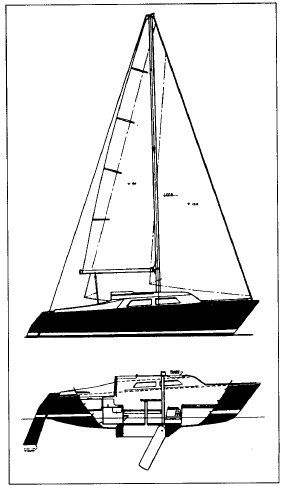
An early brochure describes the PY 23 as “a second generation refinement of the trailerable concept which eliminates the awkwardness in handling and sailing often present in the early trailerables.” Indeed, the boat was rated 18.0 for IOR Quarter Ton and 16. 9 under the MORC rule. Modern looks were derived largely from the flat sheer and reverse transom.
Instead of the more common swing keel, in which all of the boat’s ballast hangs on a single pivot pin, Deknatel gave the PY 23 a 40-pound centerboard that retracts into a 900-pound “shallow draft lineal keel.” This arrangement eliminates a trunk intruding into the cabin space, and places the majority of ballast a bit lower (it draws 1′ 9″ board up) than in boats, such as the Aquarius 23, in which the ballast is simply located under the cabin sole. The downside is a bit more draft, which means you need to get the trailer that much deeper to float the boat on and off. (We once owned a Catalina 22, which draws 2′ 0″ keel up, and often had to use a trailer tongue extension-built in-to launch and haul out.) Based on our experience, any draft under 2 feet should be relatively easy to trailer and launch. Difficulties seem to mount exponentially with every inch of added draft.
Like most trailer-sailers, the PY 23 has an outboard rudder that kicks up for beaching.
Recognizing that trailer-sailers are not built for rugged conditions, and that by necessity they are not big boats, we herewith list some of the more common owner complaints: no backrests in cabin, barnacles in centerboard well, not enough room in head, not an easily trailerable boat, rudder rot, and poor ventilation in forepeak.
On the plus side, owners say the boat is quick, well built, balances well, has good-quality mast and rigging, a comfortable cockpit, and a livable interior.
In all, we think this is a good example of the trailer-sailer. We like the keel/centerboard arrangement, even though it adds a few precious inches to board-up draft. It sold in 1974 for $8,150 base. Today, it would sell for about $5,100. A superior choice in our book.
Yankee Pacific Dolphin 24
Yankee Yachts of Santa Ana, California, was a major builder during the 1970s, known mostly for its IOR boats. The Pacific Dolphin 24, designed by Sparkman & Stephens, is a classiclooking boat, not unlike the more familiar S&S-designed Tartan 2 7. It was built between about 1969 and 1971, when it was replaced by the Seahorse 24, designed by Robert Finch, who helped design the immensely successful Catalina 27.
The reason, we surmise, was that the Dolphin has a long keel drawing 2′ 10″, and though the company initially thought it would appeal to trailersailers, it’s draft, plus 4,250-pound displacement, made it difficult to launch and retrieve. In contrast, the Seahorse drew 1′ 8″, displaced 2,800 pounds, and has a scabbard-type removable rudder.
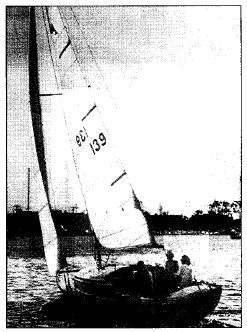
The Dolphin has 1,750 pounds of ballast, all in the keel. The attached rudder makes this boat a bit more rugged than most trailer-sailers, and its overall quality, including extensive teak joinerwork below, places it in a different category.
Owners report very few problems with the Dolphin other than a comparatively large turning radius, and cramped living quarters; most have only good things to say. An Oregon owner said, “Using a 3/4-ton pickup with a 390 engine we go uphill at 30 mph and down at 55. It takes us a couple of hours to rig and get underway, but it sure beats paying slip fees.” He also cites the Dolphin’s speed, saying he keeps pace with a Cal34, trounces a Balboa 26 and Catalina 27, and has only “lost” to a San Juan 21 going upwind. A Washington owner says she is very seakindly, with just the right amount of helm, though a bit tender due to narrow beam. Most owners use a 6-hp. outboard in the well, though one said he opted for a 15-hp. outboard for better performance, and because it can charge the batteries. Construction is reported as heavy.
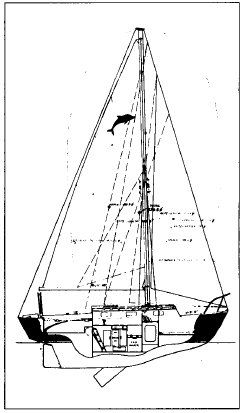
In 1971 the boat sold new for $5,995.Prices now are around $7,500, which for an original owner would have made it the best investment of these four boats. While we have always liked the Dolphin, we don’t view it as suitable for regular trailering. More likely, you’d keep it at a slip during the sailing season, parking it at home on its trailer after haul-out.
American 26
Costa Mesa, California was the epicenter of 1970s boatbuilding. American Mariner Industries is one company, however, better forgotten. It was in business from about 1974 to 1983. Its American 26 was a 25 first. A 1974 brochure says, “This 25-footer so completely justified our judgment as to the efficacy of our unique stabilizer keel and hull . . . that we have moved on to provide the trail-and-sail cruising enthusiast with a choice of two versions-the American 23 and the American 26.” This seems to imply that the same hull mold was used.
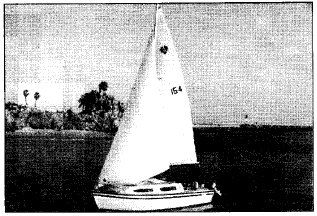
In any case, what is unique about this line of boats is the wide, partly hollow keel that makes a sort of trough in the cabin sole to provide standing headroom. It is not wide, but does run nearly the length of the main cabin. Ballast is 900 pounds of lead laid in the bottom of the keel. Draft is 2′ 4″ for trailerability, but there is no centerboard, and due to the keel’s extreme width, you can imagine that windward performance is poor. Unfortunately, we have no owner feedback on this boat to corroborate our assessment.
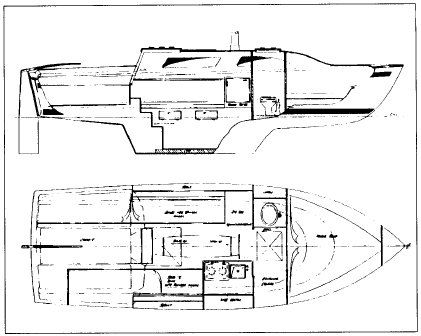
The boat sold new in 1974 for $8,995 base. The BUC Research Used Boat Price Guide says today it’s worth about $6,000. Frankly, this design, which severely compromises sailing performance for standing headroom, seems ill-conceived. One can only guess at how many people have cracked their skulls stepping up out of the trough.
Aquarius 23
Coastal Recreation, Inc., also of Costa Mesa, was around from about 1969 to 1983. It acquired the Balboa line of trailer-sailers, and for a time built the LaPaz 25 motorsailer.
The Aquarius 23, and its smaller sistership the Aquarius 21, were designed by Peter Barrett, a Webb Institute graduate and national champion in Finns and 4 70s. The Aquarius 23 is not much prettier to look at than the American 26, though it sails surprisingly well. Because highway trailering laws restrict the beam to 8 feet, the Aquarius 23 comes in just under at 7′ 11″ and relies on it for stability. ” Most of the 815 pounds of ballast is in the hull. A large center- board retracts fully into a trunk, which is more or less concealed in the cabin as a foundation for the drop-leaf table. A peculiarity is that persons sitting at the table are all on the starboard side, and the forward person is forward of the main bulkhead, essentially in the head, though there is a fore-andaft bulkhead making the toilet reasonably private (another important issue for trailersailers).
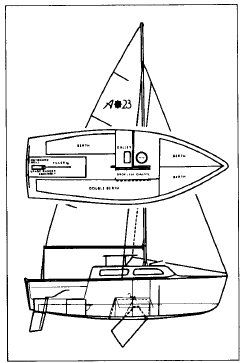
Like the Paceship PY 23 and many other trailer-sailers, the Aquarius 23 has a pop-top to provide additional headroom. We think this is more sensible than the American’s keel trough, but we do caution that pop tops can leak and aren’t designed for offshore use.
Another unusual feature of the Aquarius is the absence of a backstay and spreaders. To support the mast, the shrouds are led aft, reflecting, we suppose, Barrett’s one-design background. If not suited for wild and woolly sailing conditions, it is at least simple to set up, and that, after all, is the goal of most trailer-sailers.
Friends of ours bought an Aquarius 23 in 1970, and we spent a good deal of time sailing with them, including several overnight crossings of Lake Michigan. The boat handled well, was reasonably quick on a reach, and had more interior room than most 23-footers. Still, we were never enamored of its looks.
Complaints from owners include lost centerboards and rudder repairs (like the Yankee Seahorse, it is an inside, removable type), poor ventilation, poor windward performance when overloaded, tubby appearance, and lack of a mainsheet traveler. Many owners say they bought the boat for its shoal draft and large interior, but that cheap construction caused numerous problems.
The Aquarius 23, in the early 1970s, sold for $6,195; today it sells for about $4,000. Though our memories of sailing this boat are all rosy, we think there are better boats available.
Our preferred solution to the keel/ ballast problem in trailer-sailers is the traditional keel/centerboard as found on the PY 23, Tanzer22 andO’Day23, all of which we recommend. The keel/ centerboard configuration eliminates the trunk in the cabin, places ballast below the hull, and does not concentrate all of the ballast weight on a pivot pin, as is the case with swing-keel designs.

We do not care for the American 26’s hollow keel, believing that if you want standing headroom, either go outside or buy a bigger boat. Nor do we care particularly for narrow shoal keels without centerboards, because windward performance suffers, or boards that leave all the ballast in the hull-whether lead, iron or water-as ultimate stability is compromised.
How one solves the choice between interior space and sailing performance is a personal decision. We, too, appreciate spaciousness down below, but at the same time have always chosen boats that looked and sailed decently, willing to give up a few inches of elbow room for a boat we could feel proud of when rowing away in the dinghy.
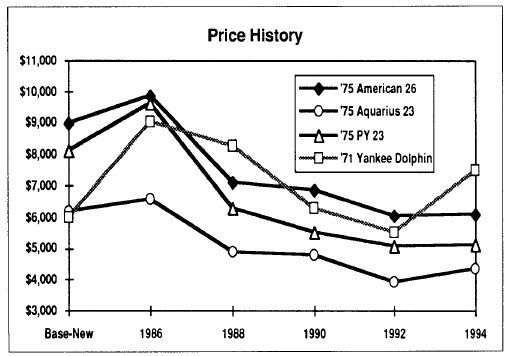
RELATED ARTICLES MORE FROM AUTHOR
So the only real complaint against the Aquarius23 is the author is not “enamoured” with it’s “looks”, whatever that means.
I think the Aquarius 23 beats them all for what they were designed for. A family of 5 and thats just what I have. The wide stern and blunt bow make it Large inside and can take a lot of wieght in the tail. I need function, rugged keel for beaching and shallow waters.
I had an Aquarius 21 for thirteen years in San Diego. I sailed it all the time, and made four trips to Catalina Island in it. It had some poor constructions flaws (like particle board coring for the deck), but it was inexpensive, and easily handled by one person. I loved it.
Hi Kevin. I’m looking at a Aquarius 21 project boat. The owner lost the title so I would have to re-title it, but can find a VIN / serial # anywhere. Can you tell me where it might be located?
I have owned and sailed a PY 23 for twenty years, and she has served me well. I have had off and on trouble lowering the centerboard, as it easily sticks in the up position (likely due to growths inside the trunk). It is difficult to gain enough leverage from inside the cabin to force it down. Other than that – the boat has been a trooper.
Have you ever evaluated the Sirius 21/22?
How about a review of the Sirius 21/22 by Vandestad and McGrewer?
LEAVE A REPLY Cancel reply
Log in to leave a comment

Latest Videos

Cabo Rico 34 Boat Review

Super Shallow Draft Sailboat: The Leeboard Sharpie

Hans Christian 41T – Boat Review

Seven dead after superyacht sinks off Sicily. Was the crew at...
Latest sailboat review.

- Privacy Policy
- Do Not Sell My Personal Information
- Online Account Activation
- Privacy Manager
- Most Popular Categories
- Boat Covers
- Boat Propellers
- Bimini Tops
- Boat Motors & Parts
- Boat Motors
- Boat Seats & Pontoon Furniture
- All Categories »
- Boats for Sale
- Boating Forums
1975 American 26
Parts, Accessories & Upgrades to Consider:
Would these parts and accessories improve your boating and experience, related links.
- Insure my American Boat
- Sell my American Boat
- Boat loan quotes
Parts & Accessories
- Anchoring & Docking
- Cabin & Galley
- Boat Hardware
- Boat Seats & Furniture
- Boat Windshields
- Controls & Steering
- Covers & Tops
- Fishing Equipment
- Fuel Tanks & Systems
- Inflatable Boats
- Life Jackets
- Maintenance & Boat Repair
- Manuals & Books
- Marine Electrical
- Marine Electronics
- Marine Engine Parts
- Nautical Gifts
- Plumbing & Pumps
- Trailers & Parts
- Trolling Motors
- Videos, CDs & Software
- Watersports
STAY CONNECTED
Sign up for our Newsletter to Receive the Latest Deals, News and More.
OUR COMPANY
Explore iboats, connect with us.
|




















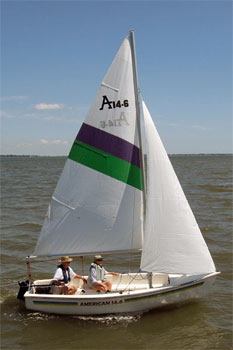



IMAGES
VIDEO
COMMENTS
A boat with a BN of 1.6 or greater is a boat that will be reefed often in offshore cruising. Derek Harvey, "Multihulls for Cruising and Racing", International Marine, Camden, Maine, 1991, states that a BN of 1 is generally accepted as the dividing line between so-called slow and fast multihulls.
American 26/27 is a 26′ 6″ / 8.1 m monohull sailboat designed by Arthur S. Henry and built by American Mariner Industries starting in 1979. ... Sail area in square feet, derived by adding the mainsail area to 100% of the foretriangle area (the lateral area above the deck between the mast and the forestay). D: ...
American preowned sailboats for sale by owner. American used sailboats for sale by owner. Home. Register & Post. View All Sailboats. Search. Avoid Fraud. ... Sailboat Added 26-Aug-2024 More Details: American Fiberglass 16' Daysailer: Length: 16'' Beam: 5'8' Year: 1978: Type: daysailer: Hull: fiberglass monohull:
American preowned sailboats for sale by owner. American used sailboats for sale by owner. Home. Register & Post. View All Sailboats. Search. Avoid Fraud. ... 26' Forrester-Custom for Sherwood Brass Herreshoff Monroe, Michigan Asking $32,000. 47' Compass 47 Puerto Penasco Mexico Asking $125,000.
The SA/D for American Marine 26 with ISO 8666 reference sail is 15.3, with a 135% genua the SA/D is 18.3. Low High 38% 0 50 100 The SA/D ratio indicates that it is faster than 38% of all similar sailboat designs in light wind.
I found a 1971 26' American Marine sailboat. I'm over 6 feet tall and I can stand up inside it. I'm new to sailing and comfort is a top priority. Is anyone familiar with this boat. Sail ability, reliability etc. I will be sailing in the Tampa Bay Fl. area and staying on it overnights on...
Its American 26 was a 25 first. A 1974 brochure says, "This 25-footer so completely justified our judgment as to the efficacy of our unique stabilizer keel and hull . . . that we have moved on to provide the trail-and-sail cruising enthusiast with a choice of two versions-the American 23 and the American 26."
This American 26 Motor Sailor sailboat has a fiberglass hull and an LOA of 26 feet (length over all). The boat has a 711 inch beam. This sailboat is set up to sail as a Sloop. The craft has 240 square feet of sail area. Displacement for the boat is 5500 lbs. The draft of this sailboat is approximately 2'4".
American Mariner Industries. Founded by Arthur S. Henry. All models were designed by Henry, who held a patent for their unique recessed cabin sole (into the keel) that provided increased interior headroom. The sales literature referred to this feature as the "stabilizer keel". As with so many other pleasure boat builders, AMI went bankrupt ...
The 1975 American 26 sailboat has a fiberglass hull and has an overall length of 26 feet (sometimes referred to as LOA). The width (or beam) of this craft is 80 inches. This boat is rigged as a Sloop. The sail area for the sailboat is 280 square feet. The displacement for the boat is approximately 4000 lbs.
displacement 4600 lbs. beam 8 ft. comes with 4 sails, main, 2 jib sails and the genoa. head rm 5' 11", 5 berths. I have sailed this boat for 5 yrs on lake erie and it is a great boat, can be sailed easily by one person. 1997 evinrude 9.9 longshaft 2 stroke. includes trailer. American 26, 1974, Brooklyn, Ohio.
The Pearson 26 is a family of American sailboats, that was designed by William Shaw and first built in 1970. [1] [2] [3] Production. The design was built by Pearson Yachts in the United States starting in 1970 and ending in 1983. The Pearson 26 was one of the company's most successful designs. A total of 1,750 of the base design were built ...
I bought a 26' American (different mfg.) in Feb, with trailer included, for $1500. I have had to spend about an additional $1000 to get it ready to sail this next month. The original asking price on Craig's list was $2500. It was iced up in Feb in Iowa and the seller was motivated. Keep looking is my advice.
American Sail Inc. 7350 Pepperdam Avenue, Charleston SC 29418. Tel.: (843) 552-8548 | Toll Free: (800) 844-2399 | Fax: (843) 552-7770 | Email: [email protected]. All of our sailboats are designed for family fun and not hard-core racing. One person can rig each boat in the line in less than 20 minutes.
Sailors love these American made sailboats. These are typically due to their reliability and comfort you can achieve while exploring blue water areas. Tartan Yachts. Image credit: Tartan Yacht. Tartan has been around since 1960 in Ohio and has developed beloved sailboats. Their most popular models are the 3400 and 4000 but they also have new ...
1. Hallberg-Rassy. Hallberg-Rassy is a Swedish yacht maker that's very well-known in the blue water cruising circles for making some of the highest quality and sturdiest sailboats. For many sailors, this is the number one sailboat brand as it offers absolute comfort, utmost safety, and good and easy handling.
Original Manufacturer / Promotional Brochure Date: 1976Pages: 4 in ColorSize: 8.5 x 11 opens to 11 x 17Condition: C7Condition Details: Worn edges, fold marksBrochure Details: Includes specification sheet / price list
american sail preowned sailboats for sale by owner. american sail used sailboats for sale by owner. Home. Register & Post. View All Sailboats. Search. Avoid Fraud. ... 26' Forrester-Custom for Sherwood Brass Herreshoff Monroe, Michigan Asking $32,000. 30' Pearson Wanderer Northport, Michigan Asking $9,000. 30' S2 9.1
Speed, comfort, safety and an easy-to-handle rig are all the hallmarks of a great daysailer: (clockwise from top) the Catalina 275 Sport, Tartan Fantail, Colgate 26 and American 18. Family boats and trainers are perhaps the toughest to categorize, given all the different shapes and sizes they come in.
American Sail Information. American Sail got its start in 1976 with the purchase of the Aqua Cat catamaran that has now been in production over 42 years and was recently inducted into the National Sailboat Hall of Fame. Our specialty for over twenty-five years has been making fun family sailboats from 8 to 18 feet. Over the years we have grown to offer many more sailboats in our line including ...
American Sail got its start over 40 years ago in 1976 with the purchase of the Aqua Cat catamaran. Over the years we have grown to offer many more sailboats in our line including a larger version of the Aqua Cat and four daysailers that are the Aqua Finn Daysailer, Pennant Daysailer, American 14.6, and American 18 Daysailer. If you're looking ...
Phone: (954) 294-6962. Email: [email protected]. Perhaps the most famous and revered 12-Metre of the modern era, Courageous won the America's Cup twice, in 1974 and 1977 and is one of only three boats with that distinction in the 169 history of the competition. An icon of American sailing, she is notable also as the first 12 ...
The Seafarer 26 is an American sailboat that was designed by McCurdy & Rhodes a cruiser and first built in 1977. Production. The design was built by Seafarer Yachts in the United States, starting in 1977, but it is now out of production. Design. The Seafarer 26 is a ...